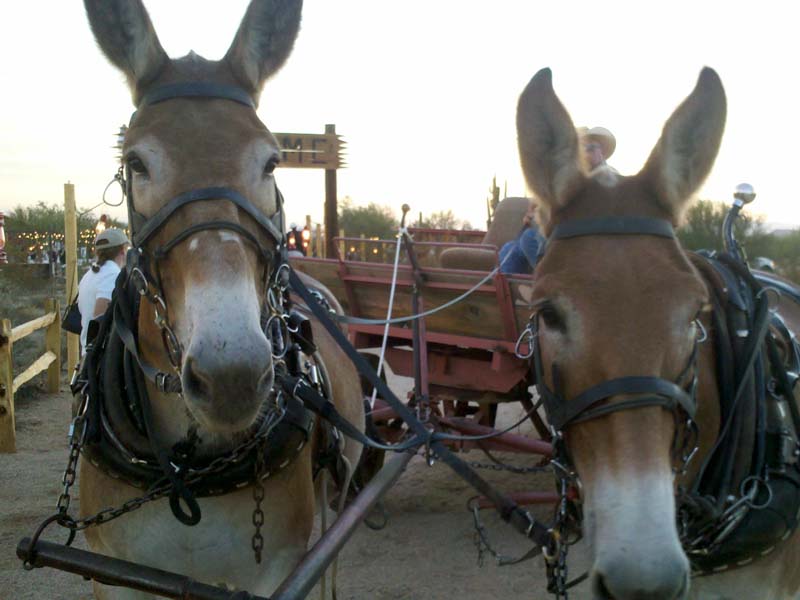[QUOTE=Risk-Averse Rider;5137515]
gothedistance - sorry for not being clear.
The woman I asked about the ropes said they put one on every team. And if they had 2 greenish horses/mules, they might put them on both.
She stressed that they have been “TRAINED” to stop when the rope is pulled. The picture she painted was that rope caused the horse/mule to lift his foot, signaling him to stop.
Kind of like you pick up a horse’s foot to keep him from moving around when the vet’s working on another foot.
In retrospect, imagining a bolting situation, I’m thinking that’s not terribly likely 
I didn’t have my camera, so I don’t have any good photos of the device. Mr. RAR did catch Junior & Friendly from the front, and you can see the white rope tied to something on the wagon.
Nice guys, were Mr. Junior & Mr. Friendly.[/QUOTE]
Hey, no need to apologize.  Thanks for the photo - it really explained a lot more. I was surprised to find the rope tied to that bar? lever(? brake pull??) on the dash - whatever that sticking-up thing is. (sorry about the preposition ending sentence) I don’t know enough about farm wagons – sadly that is the one gaping hole in my long resume of carriage education. :lol::lol::lol: If it is a brake, I could see (sorta, but sorta not, too) how if they pulled the brake they would get a twofer. <narrowing eyes and thinking very deep and very hard about that one, but not finding much, if any, value in that set-up whatsoever.>
Thanks for the photo - it really explained a lot more. I was surprised to find the rope tied to that bar? lever(? brake pull??) on the dash - whatever that sticking-up thing is. (sorry about the preposition ending sentence) I don’t know enough about farm wagons – sadly that is the one gaping hole in my long resume of carriage education. :lol::lol::lol: If it is a brake, I could see (sorta, but sorta not, too) how if they pulled the brake they would get a twofer. <narrowing eyes and thinking very deep and very hard about that one, but not finding much, if any, value in that set-up whatsoever.>
But…if it is just a dashboard decoration…well, I would honestly doubt whether the rope would do a spit’s worth of good in a pinch. It needs to be held in a hand to be used. Tied up it is no good at all. Either way that bar/lever is held in with one bolt (probably) on a wooden dash - not the safest option. Too easily broken, possibly shattering the dash, too, if extreme push comes to extreme shove. Then you’ve lost both your brakes (if that is one) and your rope, bouncing on the ground behind the heels of your mules. <widening eyes as I think about this. Wow. My brain is actually starting to hurt trying to fit this all in. But it is interesting!>
Couldn’t quite tell, but I assume the rope had to have enough slack to allow the mules to walk, yet not enough to let them jog? Is that right, or did they jog to and fro the event from what you remember?
On a side note – those white haired markings on the mule’s face really jumped out at me. Rough handling produces those kind of white markings - maybe past evidence of a tight tiedown or super tight noseband that was employed to either tie down the head, or keep it from stargazing (one of the positions a bolter will do first is throw up the head as high as it can). That sure is a wink-wink nudge-nudge to me as to why he was the one “honored” for the ankle rope. :winkgrin::yes: Then again, maybe he was just being a mule - ie: “stubborn to the point of a skinner’s curses and tears”. But gotta admit - both Jr and Friendly sure do look both adorable and sweet. 
I’m guessing hitch may have hit the nail on the head when he suggested that the rope may well be the mitigation the outfit’s insurance provider wanted in lieu of the recent runaway wreck at that parade. However, the way they have it set up (tied up when it absolutely must be hand held) means it really is just a passing nod to the safety demands. It certainly isn’t something they will be able to use, or get to in time if things go from good to bad in a microsecond.
Again, just my humble <learned> opinion.




